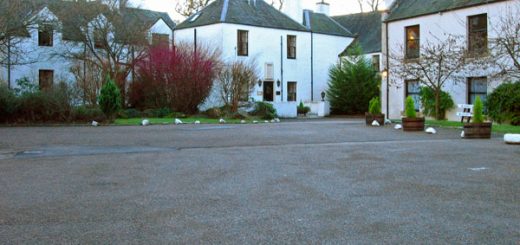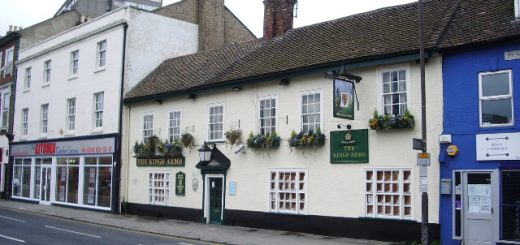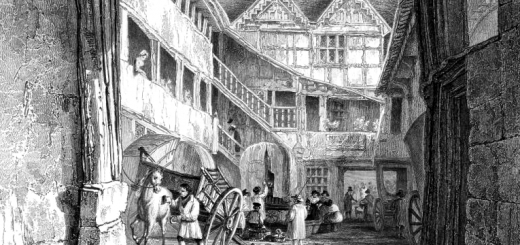Mary King’s Close
A close such as Mary King’s Close is a narrow lane or passage that runs between two buildings or a route that would give access to the rear of a building. Probably to stay close to the protection of the castle and be within the city walls, Edinburgh saw a large number of high multi-story tenement buildings being built going up the steep hillside on either side of the Royal Mile and closes would run between them. A close probably got its name because at night a gate could be closed at each end, securing the buildings it served and the inhabitants.
![The Real Mary King's Close at en.wikipedia [Public domain], via Wikimedia Commons](http://www.mysteriousbritain.co.uk/wp/wp-content/uploads/2018/12/Marykingsclose006-201x300.jpg) Mary King’s Close, possibly named after the daughter of Alexander King a wealthy property owner ran from High Street all the way down to Market Street, before Cockburn Street was built. In 1645 the inhabitants of the buildings served by Mary King’s Close were stricken with the plague. It had probably come from rats arriving in Edinburgh through Leith docks. In order to quarantine them and prevent the spread of the disease throughout Edinburgh, Mary King’s Close was sealed, possibly according to legend with some people still alive and suffering inside. There is a story that with housing shortages becoming a worry, the people of Edinburgh wanted to open up Mary King’s Close but needed the bodies removing. It is said they hired two brothers to go in and remove the corpses, but they struggled carrying them up and down the stairs in the tall buildings, so they decided to hack the bodies into pieces so that they could be disposed of easier. Whether the story of the two brothers is true or not, Mary King’s Close was opened and the houses reoccupied due to overcrowding.
Mary King’s Close, possibly named after the daughter of Alexander King a wealthy property owner ran from High Street all the way down to Market Street, before Cockburn Street was built. In 1645 the inhabitants of the buildings served by Mary King’s Close were stricken with the plague. It had probably come from rats arriving in Edinburgh through Leith docks. In order to quarantine them and prevent the spread of the disease throughout Edinburgh, Mary King’s Close was sealed, possibly according to legend with some people still alive and suffering inside. There is a story that with housing shortages becoming a worry, the people of Edinburgh wanted to open up Mary King’s Close but needed the bodies removing. It is said they hired two brothers to go in and remove the corpses, but they struggled carrying them up and down the stairs in the tall buildings, so they decided to hack the bodies into pieces so that they could be disposed of easier. Whether the story of the two brothers is true or not, Mary King’s Close was opened and the houses reoccupied due to overcrowding.
The new inhabitants of Mary King’s Close found the buildings to be haunted and various reports were made of apparitions including a dog, headless animals, a young girl and several severed limbs and body parts such as heads. The inhabitants were then evicted in 1753 to make way for a new building project. The upper stories of the buildings around Mary King’s Close and its immediate neighbours were demolished and The Royal Exchange, now the City Chambers was built on top of them. Designed by John and Robert Adam, the City Chambers is a three story building with three sides that surround a piazza. The lower eight stories of beneath the City Chambers, dropping down to Cockbum Street were sealed up, including Mary King’s Close.
Sealed for two hundred and fifty years, Mary King’s Close has now been re-opened for tour groups and you can go down beneath the City Chambers to the lane and buildings that still exist, hidden away. Recent visitors have reported seeing a young girl and dog down there and battery operated equipment like cameras and torches have drained of power.




We went on the tour
We went on the tour of Mary King’s close this week as we were up in Edinburgh for a couple of nights. After walking though the closes and wynds that are still in use it was very interesting to go under the City Chamber buildings to see one of the closes as it was over two hundred years ago.
The tour was good, not too dramatic but very atmospheric, and suprisingly it focussed more on the people that lived there rather than concentrating just on the haunting stories (although when the lights go out and the tour guide is describing a ghostly encounter it does get a bit spooky!) One of the ghosts reported to have been heard is that of a young girl and in the room where she was heard there is now a ‘shrine’ of toys brought from visitors over the years.
It was a strange feeling knowing that you are underneath a modern(ish) building and walking through rooms where people lived and died for hundreds of years but it gives a very real insight into life in the city centuries ago and it’s well worth a visit.
I would recommend booking in advance though if you are visiting in holidays or at the weekend as it gets full quickly! http://www.realmarykingsclose.com
Re: Mary King’s Close
There is a persistent myth that in an effort to quarantine the victims, Edinburgh city officials sealed off Mary King’s Close in 1644, leaving some 600 inhabitants to perish inside without hope.
In reality, the plague victims were well cared for, and the town council managed the outbreak efficiently and compassionately. Families healthy enough to be moved were taken to Burgh Muir. Those who weren’t able to be moved let the workers know by putting up white flags in their windows so that food and coal could be delivered to their doorsteps. The plague doctor George Rae, then came into the town wearing leather from head to toe and a bizarre bird shaped masks to help protect him from the disease. (It worked, the leather kept the fleas from biting Rae and he survived the outbreak.) To save a plague victim, Rae would slice off the top of the victim’s sore and jam a red hot poker into the wound to cauterize it. While no doubt horrible, the technique did indeed save lives.
After the plague had passed, tenants continued to live in Mary Kings close until the 19th century, when it was emptied and sealed up. The Royal Exchange was built on top of it and the close was forgotten. It wasn’t rediscovered until workmen digging on the street above accidentally punched down into the winding streets.
Re: Mary King’s Close
Your quite right Kristopher, the inhabitants of Mary Kings Close were infact cared for and the close was not sealed in a bid to protect the rest of the city. It is a myth or piece of local folklore and one that ties in with the story of dismembered apparitions supposedly being seen. I am sure that parts of the street accessible for some time before the Royal Exchange was extended, and one of the last inhabitants ran a saw doctors shop on the close.
Re: Mary King’s Close
The Haunted Homes and Family Traditions of Great Britain by John Ingram (1897)
Old Edinburgh was full of quaint, narrow, antiquated passages, some of which still exist, and these ”Closes," as they are locally called, contained numerous houses bearing the reputation of being haunted. Mary King’s Close was noted for the many terrible apparitions which had found suitable quarters within its mouldering dwellings. Mary King’s Close has disappeared to make way for modern erections; but just two centuries ago, that is to say, in 1685, it was a well-to-do thoroughfare, the residence of a respectable class of people. George Sinclair, Professor of Moral Philosophy in the University of Glasgow, and afterwards minister of Eastwood, in Renfrewshire, a contemporary of the events he refers to, gives the following account, in Satan’s Invisible World Discovered, of some terrible apparitions in Mary King’s Close, in the house of Mr. Thomas Coltheart, a respectable law agent. Mr. Coltheart’ s business having improved, he removed into a superior residence in the Close above-named. Having been warned by some kind neighbour that the house was haunted, the maid-servant decamped in haste, and left Mr. Coltheart and his wife to manage as they best could. On Sunday afternoon Mr. Coltheart, being unwell, retired to rest, whilst his wife seated herself at his bedside and read the Scriptures. Happening to raise her eves, she was intensely horrified to behold the head of an old man, with grey floating beard, suspended in the air but a short distance oft’, gazing at her intently with weird, fixed glare. She swooned at the sight, and remained in an insensible condition until the neighbours came back from church. Her husband did his best to reason her out of her credulity, and the evening passed without anything further taking place.
They had not been in bed long, however, before Mr. Coltheart also beheld the phantom head, floating in mid-air, and surveying him with ghostly eyes. He got up and lit a candle, and then betook himself to prayer. An hour passed, when the spectre head was joined by that of a child, also suspended in the air, followed speedily by an arm naked from the elbow, which, despite the lawyer’s pious ejaculations, seemed to wish to shake hands with him and his wife! In vain did Mr. Coltheart conjure the phantoms to entrust him with the story of their grievances, so that he might have their wrongs rectified : all was useless. They seemed to regard him and his wife as intruders, and to wish them away. Other phantoms joined them, including that of a dog, which curled itself up on a chair, and seemed to go to sleep ! Others some of a most horrifying and monstrous form appeared, until the whole room swarmed with them : and the unfortunate couple were compelled to take refuge on the bed. Suddenly, with a deep and awful groan, all the apparitions vanished, and the pious lawyer and his wife were left in peace.
After such a terrifying house-warming, one would suppose that Mr. and Mrs. Coltheart would have got out of the house as quickly as possible ; but such was not the case. The brave couple, if Professor Sinclair is to be relied on, continued to reside in the place for many years, and till the day of Mr. Coltheart’s death, without anv further molestation from the spirits.
About the time of Mr. Coltheart’s death, a strange circumstance happened. A client of his who lived at Tranent, ten miles from Edinburgh, was aroused in the night by a nurse, who had been affrighted by " something like a cloud moving about the room." Starting up, the gentleman instinctively seized his sword, when he was confronted by the face and form of his legal adviser and friend, Thomas Coltheart. " Are you dead ? " he demanded; " what is your errand? whereupon the apparition shook its head twice, and melted away. The gentleman started at once for Edinburgh, and proceeded directly to his friend’s house in Mary King’s close, and on arriving there found Mrs Coltheart bewailing her husband’s recent death.